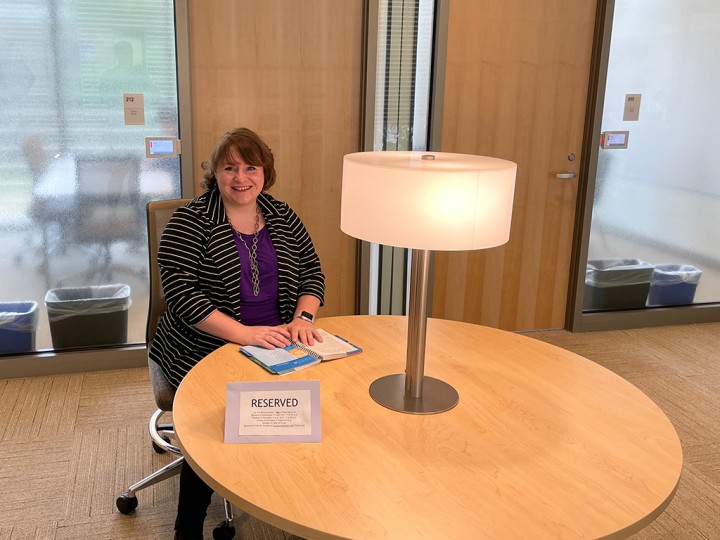Anna Scanlon is the new director of Kenyon’s Writing Center after longtime director Jeanne Griggs retired in spring 2022. The Writing Center, located on the second floor of Chalmers Library, offers walk-in hours, but students may also book appointments with individual writing consultants. Specific courses, mostly introductory, may also have a writing liaison assigned to that class.

Scanlon holds bachelor’s and master’s degrees in English from the University of Akron. From 2013 to 2019, Scanlon worked as a graduate teaching assistant at Marquette University in Milwaukee, where she taught classes on rhetoric in the English department. After earning her doctorate in 2019, she joined Illinois Wesleyan University as writing center director.
We spoke with Scanlon about what she looks forward to about Kenyon and the Writing Center.
Why did you choose to come to Kenyon?
Coming from Ohio originally, Kenyon has always been on my radar as a place where writing is of deep importance. The respect this campus has for writing drew me in, but the people I met during my visits here solidified my desire to be a part of this college community. It is a place where writing happens, yes, but it is also a kind place.
What is one piece of advice that you would give to any writer?
Don’t be afraid of writing. It might sound a bit corny, but all the research I’ve read and compiled over the years boils down to one fact time and time again: writing produces anxiety in all of us to greater or lesser degrees at some point in our lives. It often feels like such high stakes are involved, whether it be writing a song we want to become famous, writing a cover letter for a job we’re desperately interested in, or even just writing a note to someone we love who is far away from us emotionally, physically, or otherwise. But writing shouldn’t be feared. It should be embraced because it can decimate fear. What a powerful thing!
What does an ideal writing center look like?
I’m not sure there is one ideal. There is a great article called “The Idea of a Writing Center” by Stephen North that I assign every year to students in the writing center courses I teach. In it, the author destroys the narrative of the writing center as a lab where you go to get your papers “fixed,” addressing some of the campus stereotypes that pervade about writing centers (we’re here for “bad writers,” whoever that is, we’re here for grammar errors only, we don’t have discipline-specific knowledge, etc.). However, he replaces it with a lot of ideals that everyone over the following 40 years, himself included, have taken to task. So, instead, if I might answer a different question: the mission of the Kenyon Writing Center community is that we strive to be a place where all students, staff, and faculty will feel their voices are heard and respected.
What are you looking forward to teaching in your classes?
My background is in medical literature, so I’ll always have a soft spot for writers who are also nurses, physicians, surgeons, midwives, etc. However, right now I’m really enjoying time exploring the concept of everyone as writers — my students in particular, in the English 217: “The Art and Craft of Analytical Writing” course I get to teach this semester. It’s beautiful to encounter so many distinct voices both on the page and in the classroom. I find myself very lucky to be able to do the work I do.
What is your favorite book?
Aw shoot, what book isn’t my favorite? I’ll go with what I'm re-reading right now: the graphic novel Taking Turns by MK Czerwiec, about the height of the AIDS pandemic in Chicago. I’ve taught it a few times and it never fails to capture my students’ attention. It’s a beautiful piece that really hits at the heart of what we continue to face, but shouldn’t, with pandemic care, discrimination, and the resulting health disparities. If you haven’t read it yet, I cannot recommend it highly enough. It’s available in Chalmers LIbrary as an ebook.